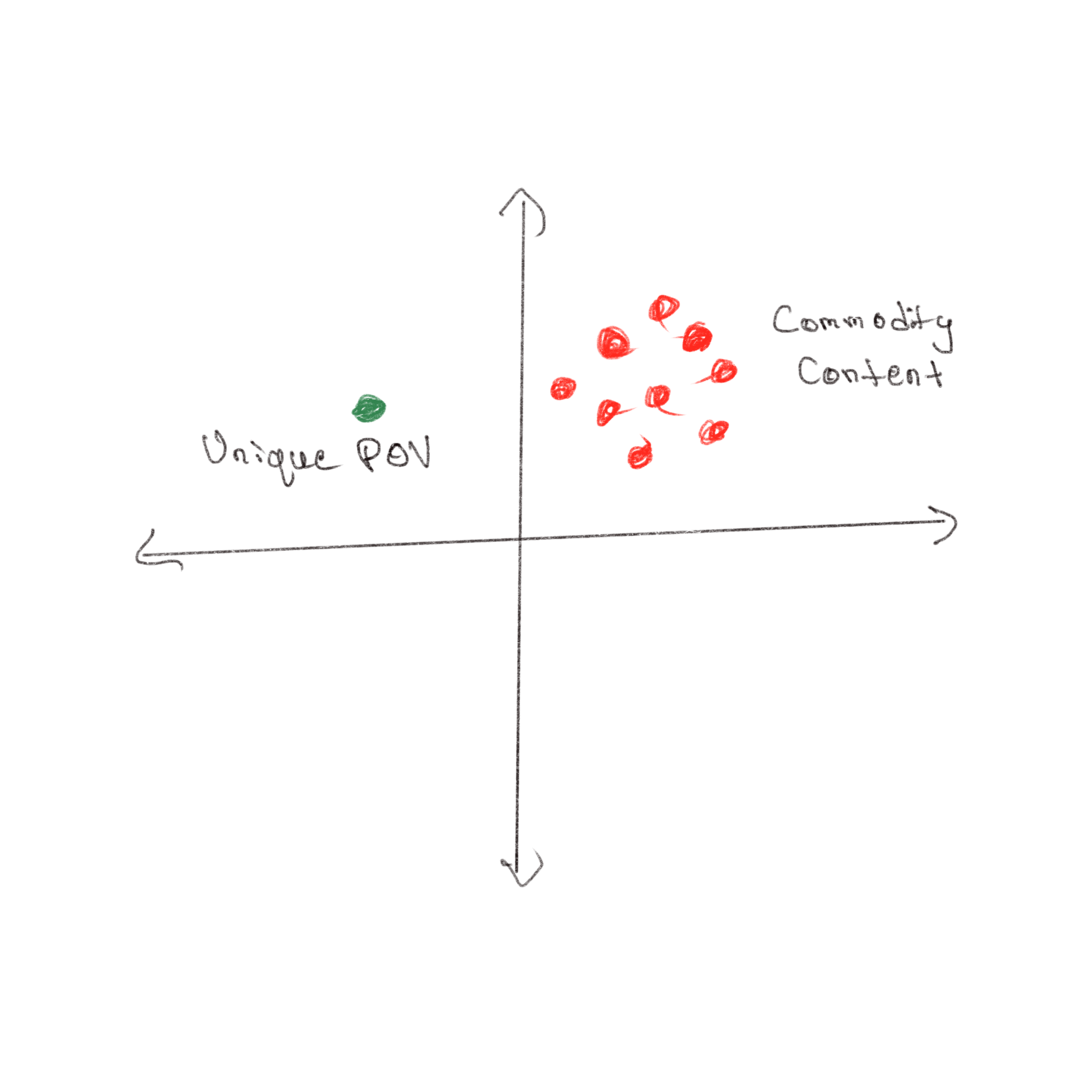If your personal brand is a solar system, then your unique POV (Point Of View) is the Sun around which all your content revolves. It’s the central idea that holds your content together. Every piece of content you produce will be directly or indirectly aligned with this POV.
I talk about POV in more detail in the previous article. (link here). This article will make more sense after reading the previous one.

Building a POV, however, is not easy
I have seen my clients (CEOs and Co-Founders) struggle with it. It’s a process that often leads to over-thinking, and we feel stuck. Going all out with our POV seems scary, so we keep second-guessing ourselves.
While crafting a perfect POV takes time, you can at least start the journey and produce version 1.0 of the POV. And then 1.1 and then 1.2, till infinity.
In this article, I will share the same framework I use with my clients to help you craft the first version of your POV.
Let’s get going.
I will continue with the cases from the previous article—David Cancel, the ex-CEO of Drift, and Jonathan Stark—and discuss their POVs while answering these questions.
Here’s the first question to consider.
- What is the shared goal?
You want to build your personal brand for a certain audience.
What does this audience want to achieve?
What is the goal they are striving for?
Drift’s ex-CEO, David Cancel, knew that businesses wanted to build relationships with their buyers. That became the first element of his POV.
Jonathan Stark knew the goals of his audience. Consultants and Experts want to deliver more impact, make more money, and work fewer hours.
Okay, now that the goal is in place, we can jump to the next question.
- Status quo – How do we go about achieving this goal?
The status quo refers to the current approach our audience is using to achieve this goal. It’s how they are trying to solve the problem today. Pretty simple, right?
David Cancel saw businesses interacting with their buyers using ‘lead forms’. Some of these lead forms were extensive, requiring prospects to fill in a lot of details before going to the next step.
Jonathan Stark’s audience (Consultants and Experts) wanted to make more impact and money, but they were charging their clients ‘by the hour’. Increasing their hourly rate was the only way to make more money.
- What are the problems with the status quo?
This is where we start generating some heat, baby. This question helps us understand what’s broken with the status quo.
What’s flawed about their current approach to achieving their goals?
What are the implications of their current approach?
David Cancel realized that lead forms are annoying for prospects. Prospects need to go through multiple fields (sometimes even 10 fields, not even kidding) before going to the next step. By the time a prospect is done filling out the form, he doesn’t feel any sense of loyalty towards the brand.
“Is there a better way?” he thought.
Similarly, Jonathan Stark realized that ‘hourly billing’ has issues. A consultant taking 2 hours to complete a task would earn more than another who finishes the same job in 1 hour. How is it fair to punish efficiency?
Jonathan realized that hourly rates make Consultants stretch their timings. In other words, they would intentionally say that they need more time to complete a particular deliverable than needed so that they could make more money. This was not fair to the clients.
David Cancel decided to attack the old game of ‘Lead forms’.
Jonathan Stark decided to attack the old game of ‘Hourly Billing’.
Okay, lets move to the next question.
- What is your big idea?
The big idea(Or the new game) is a different way of doing things. It’s a war cry against the villain, which is the old game. This is perhaps the hardest step.
You might feel that you don’t have a strong enough ‘big idea’. My suggestion?
Just. Pick. Something.
For now.
Keep coming back to it and keep refining it.
The big idea should be authentic to you
Your big idea cannot contradict your product/service.
For Jonathan Stark and David Cancel, their big idea became foundational to their personal brands and businesses.
David Cancel attacked the old game of ‘lead forms’ with his big idea of ‘Conversational Marketing’. Conversational Marketing was all about building relationships with the buyers using an intelligent, conversational chatbot that creates a much superior experience than a lead form.
Jonathan Stark’s big idea is “Value Pricing”. Value Pricing attacks the old game of ‘hourly billing’. With hourly billing, you charge based on how many hours you work for a client. But with Value Pricing, it’s all about the results you get for the client.
- What is the Proof?
Lastly, you need to back up your big idea with some kind of proof – either your own case studies or your observations about others. Jonathan Stark would need to use his own example, examples of his clients, or the examples of other consultants who are using this method of Value Pricing and are happier as a result.
David Cancel would need to do the same about “Conversational Marketing”.
To summarize:
Building a POV is essential for your personal brand to stand out, however, it can be an evolving process. Here are a few questions that will help you draft the first version of your POV –
- What is the shared goal?
- Status quo – How do we go about achieving this goal?
- What are the problems with the status quo?
- What is your big idea?
- What is the Proof?
In the next article, I will be talking about how I am building my POV.
